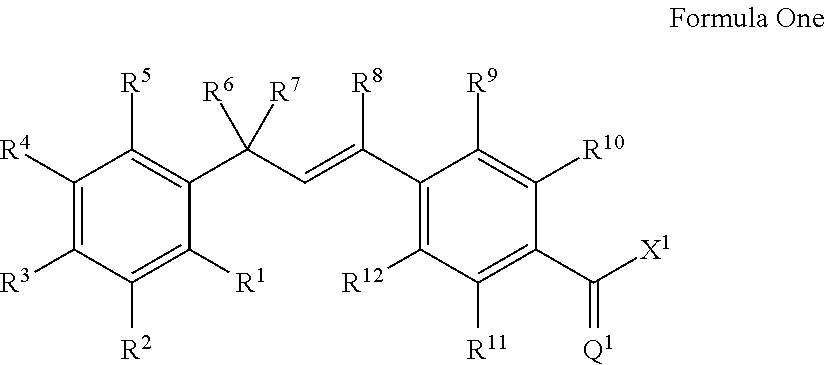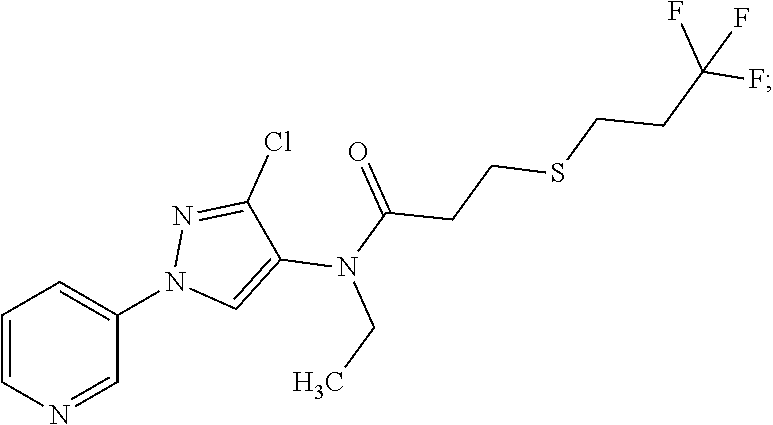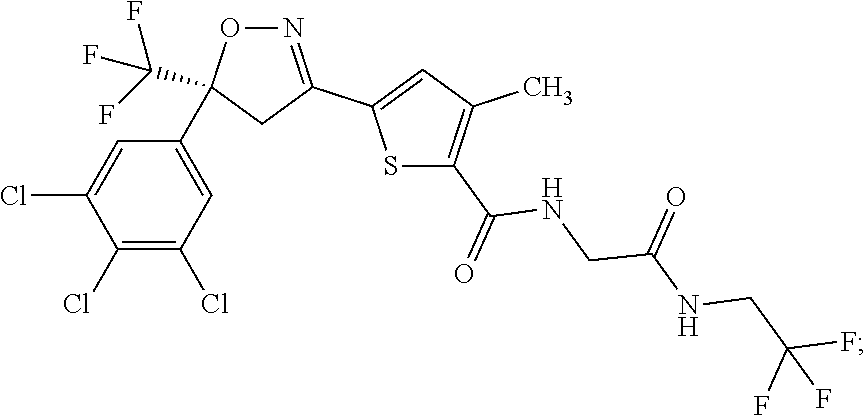Molecules having pesticidal utility, and intermediates, compositions, and processes, related thereto
a technology of pesticidal utility and molecules, applied in the field of molecules having pesticidal utility, can solve the problems of destroying more than 40% of all food production, prone to loss, and often one of the most insidious and costly problems
- Summary
- Abstract
- Description
- Claims
- Application Information
AI Technical Summary
Benefits of technology
Problems solved by technology
Method used
Image
Examples
example 1
on of (Z)-2-bromo-4-(1,4,4,4-tetrafluoro-3-(3,4,5-trichlorophenyl)but-1-en-1-yl)benzoic Acid (C1)
[0227]
[0228]To a 25 mL round-bottomed flask were added 2,2′-bipyridine (0.255 g, 1.63 mmol), 2-bromo-4-(1-fluorovinyl)benzoic acid (C34) (1.00 g, 4.08 mmol), and 5-(1-bromo-2,2,2-trifluoroethyl)-1,2,3-trichlorobenzene (2.79 g, 8.16 mmol) in N-methylpyrrolidone (2.0 mL) to give a yellow solution. Copper(I) bromide (0.117 g, 0.816 mmol) was added and the reaction mixture was purged with nitrogen for 5 minutes. The reaction was then heated to 150° C. for 3 hours. The reaction mixture was poured into ice water (100 mL). The water was filtered and the resultant black gum was dissolved in ethyl acetate (800 mL), washed with brine (2×200 mL), and water (2×200 mL), dried over magnesium sulfate, filtered, and concentrated to provide the title compound as a brown oil (1.40 g, 64%): 1H NMR (400 MHz, CDCl3) δ 8.03 (d, J=8.2 Hz, 1H), 7.89 (d, J=1.8 Hz, 1H), 7.59 (dd, J=8.3, 1.8 Hz, 1H), 7.43 (s, 2H),...
example 2
on of (Z)-4-(3-(3,4-Dichloro-5-vinylphenyl)-1,4,4,4-tetrafluorobut-1-en-1-yl)-2-(trifluoromethyl)benzoic Acid (C28)
[0286]
[0287]Tetrakis(triphenylphosphine)palladium(0) (70 mg, 0.061 mmol) was added to a solution of (Z)-4-(1,4,4,4-tetrafluoro-3-(3,4,5-trichlorophenyl)but-1-en-1-yl)-2-(trifluoromethyl)benzoic acid (C2) (0.3 g, 0.605 mmol) in toluene (3.0 mL) at room temperature. The reaction mixture was degassed by purging with nitrogen (3×10 minutes). Tributyl vinyl stannane (0.384 g, 1.21 mmol) was added to the reaction mixture. The reaction mixture was again degassed by purging with nitrogen (3×10 minutes) and stirred at 110° C. for 12 hours. The reaction mixture was quenched with water and then extracted with ethyl acetate. The organic layer was dried over sodium sulfate, filtered, and concentrated. Purification by flash column chromatography using 30% ethyl acetate / hexanes provided the title compound as a pale yellow wax (0.30 g, 94%): 1H NMR (400 MHz, CDCl3) δ 9.76 (s, 1H), 8.02...
example 3
on of (Z)-4-(3-(3,4-dichloro-5-(difluoromethyl)phenyl)-1,4,4,4-tetrafluorobut-1-en-1-yl)-2-(trifluoromethyl)benzonitrile (C32)
[0295]
[0296]Bis(2-methoxyethyl)aminosulfur trifluoride (0.282 g, 1.276 mmol) was added to a solution of (Z)-4-(3-(3,4-dichloro-5-formylphenyl)-1,4,4,4-tetrafluorobut-1-en-1-yl)-2-(trifluoromethyl)benzonitrile (C79) (0.300 g, 0.638 mmol) in dichloromethane (6.5 mL) at room temperature. One drop of methanol was added and the reaction mixture was stirred at 20° C. for 12 hours. The reaction mixture was quenched with water (50 mL) and then extracted with ethyl acetate (15 mL). The organic layer was dried over sodium sulfate, filtered, and concentrated. Purification by flash column chromatography using 35% ethyl acetate / hexanes provided the title compound as a white wax (0.100 g, 30%): 1H NMR (400 MHz, CDCl3) δ 7.96 (d, J=1.7 Hz, 1H), 7.93-7.85 (m, 2H), 7.62 (dd, J=13.4, 2.0 Hz, 1H), 7.42 (d, J=5.1 Hz, 1H), 6.95 (t, J=54.6 Hz, 1H), 5.98 (dd, J=32.2, 9.6 Hz, 1H), 4...
PUM
 Login to View More
Login to View More Abstract
Description
Claims
Application Information
 Login to View More
Login to View More - R&D
- Intellectual Property
- Life Sciences
- Materials
- Tech Scout
- Unparalleled Data Quality
- Higher Quality Content
- 60% Fewer Hallucinations
Browse by: Latest US Patents, China's latest patents, Technical Efficacy Thesaurus, Application Domain, Technology Topic, Popular Technical Reports.
© 2025 PatSnap. All rights reserved.Legal|Privacy policy|Modern Slavery Act Transparency Statement|Sitemap|About US| Contact US: help@patsnap.com



